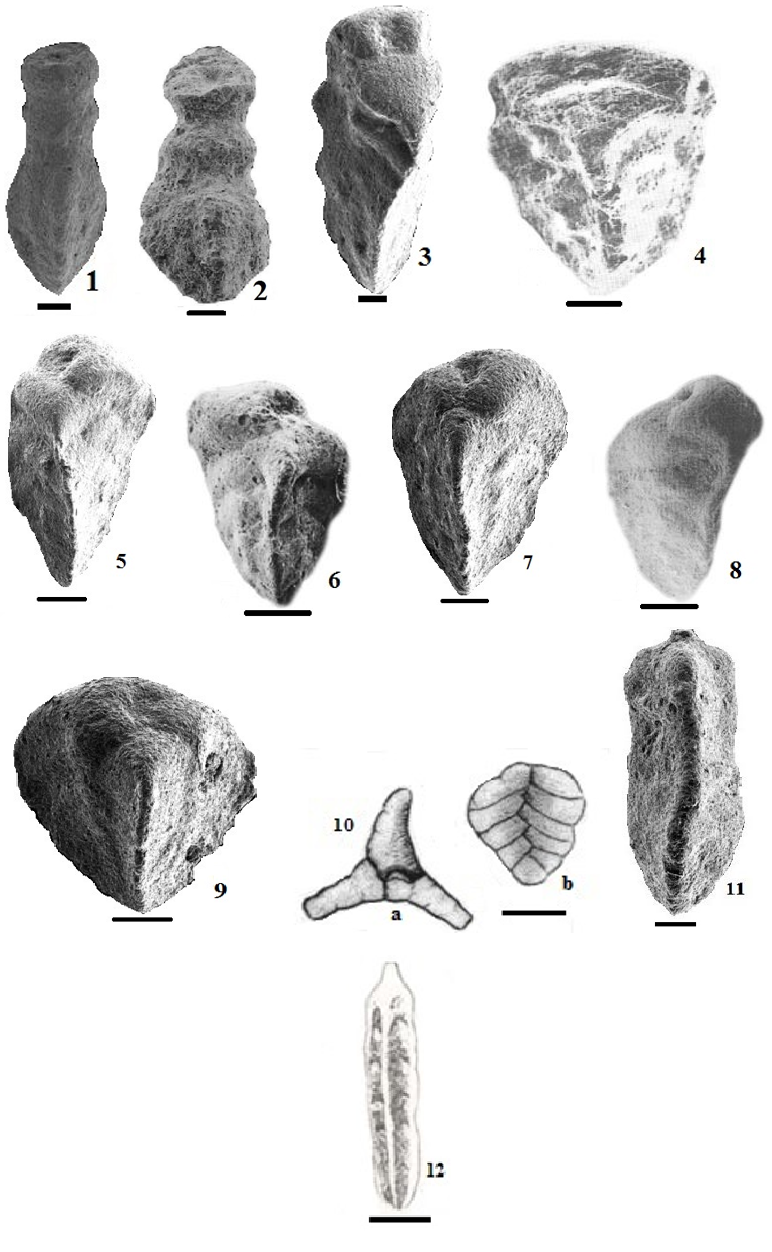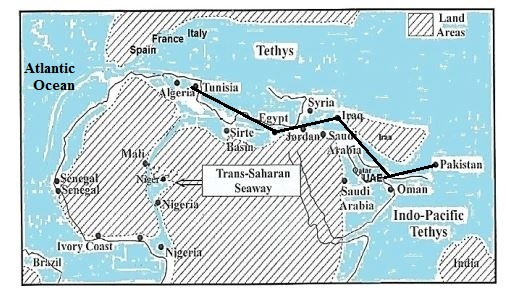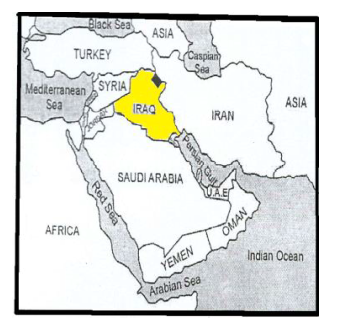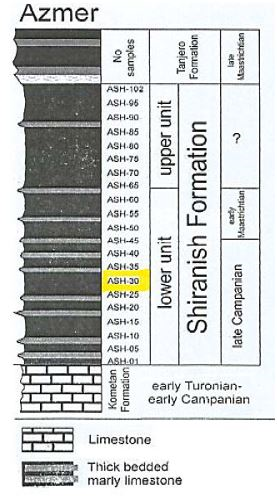Journal of
eISSN: 2373-437X


Review Article Volume 11 Issue 1
Professor of Stratigraphy and Micropaleontology, Al Azhar University-Gaza, Palestine
Correspondence: Haidar Salim Anan, Emeritus, Former Vice President of Al Azhar University-Gaza, Professor of stratigraphy and micropaleontology, P. O. Box 1126, Palestine
Received: January 27, 2023 | Published: February 10, 2023
Citation: Anan HS. Homeomorphy of some benthic foraminiferal species in the Southern Tethys. J Microbiol Exp. 2023;11(1):35-41. DOI: 10.15406/jmen.2023.11.00383
Six diagnostic Maastrichtian foraminiferal species have been recorded and illustrated from two sections Dokan and Azmer sections in the Kurdistan region, Northeast Iraq. This assemblage proposed with other species in three countries in the Southern Tethys (Tunisia, Egypt, Iraq, United Arab Emirates and Pakistan) a homeomorphic phenomenon. The phenomenon known as homeomorphy, in which an organism simulates an unrelated organism in form and function. In biology the homeomorphy is the evolution of similar external forms from very distant ancestors, happening as a result of convergent evolution, while in paleontology this phenomenon means the existence of two or more fossil taxa that appear to have similar morphology, although they are unrelated, which they might occur in rather different stratigraphic levels, and the test consists of a number of chambers that arrange in numerous shapes and sizes. The present study added additional six benthic foraminiferal homeomorphy: (1) the Late Campanian Pseudoclavulina farisi Anan n. sp. and Paleocene P. hewaidyi Anan, (2) the Late Campanian Gaudryina acuta Anan n. sp. and the Danian Gaudryina limbata Said & Kenawy, (3) the Late Campanian Gaudryina jaffi Anan n. sp. and the Early Eocene G. ameeri Anan, (4) the Late Campanian Gaudryina lawai Anan n. sp. and the Early Eocene G. speijeri Anan, (5) Verneuilina iraqensis Anan n. sp. and the Early Eocene V. luxorensis Nakkady, (6) the Late Campanian Tritaxia longa Anan, n. sp. and the Early Eocene Tritaxia elongata (Haque).
Keywords: campanian, cenozoic, homeomorphy, benthic foraminifera, southern tethys
The phenomenon known as homeomorphy, means an organism simulates an unrelated organism in form and function. In biology the homeomorphy is the evolution of similar external forms from very distant ancestors, happening as a result of convergent evolution. In paleontology this phenomenon means the existence of two or more fossil taxa that appear to have similar morphology, although they are unrelated. They might occur in rather different stratigraphic levels, and the test consists of a number that are formed in different shapes and size. Most of the cases of Homeomorphy are of the planktic foraminiferal species like the Late Paleocene-Early Eocene Morozovella velascoensis (Cushman),1 and Early-Middle Eocene Morozovella caucasica (Glaessner),2 compared to the few cases of benthic foraminiferal species exhibiting homeomorphy. In this study, six cases of agglutinated benthic foraminiferal homeomorphy are presented from the Southern Tethys: Egypt, Iraq, UAE and Pakistan. (Figure 1)These include (1) Pseudoclavulina Anan n. sp. and P. hewaidyi Anan, (2) Gaudryina acuta Anan n. sp. and Gaudryina limbata Said & Kenawy, (3) Gaudryina jaffi Anan n. sp. and G. ameeri Anan, (4) Gaudryina lawai Anan n. sp. and G. speijeri Anan, (5) Verneuilina iraqensis Anan n. sp. and V. luxorensis Nakkady, (6) Tritaxia longa Anan, n. sp., and Tritaxia elongata (Haque).
Previous studies
An attempt was treated by Seiglie3 for three soritid benthic foraminiferal genera. Anan (in press)4 was presented three cases of homeomorphy in benthic foraminifera: (1) the Paleocene Annulofrondicularia nakkadyi (Futyan) and the Late Eocene A. sztrakosae (n. sp.), (2) the Late Eocene Marginulina karimae (Anan) and the Pleistocene M. coarctata Silvestri, (3) the Middle Eocene Hemirobulina bassiounii Anan and the Oligocene-Miocene H. hantkeni (Bandy).
Some modern references have been added to complete description and taxonomic considerations. The generic concept of the twelve identified agglutinated species in this study are adapted according to the taxonomic classification of Loeblich & Tappan,5 and presented in Plate 1.

Plate 1 Pseudoclavulina farisi Anan (n. p.), 2. P. hewaidyi Anan (2008), 3. Gaudryina acuta Anan (n. p.), 4. G. limbata Said & Kenawy (1956), 5. Gaudryina jaffi Anan (n. p.), 6. G. ameeri Anan (2012), 7. Gaudryina lawai (Anan, n. p.), 8. G. speijeri (Anan, 2012), 9. Vernuilina iraqensis (Anan, n. p.), 10. V. luxorensis Nakkady (1950), a. apertural view, b. side view, 11. Tritaxia longa Anan (n. p.), 12. T. elongata (Haque, 1956).
(All scale bars 100µm)
Order Foraminiferida Eichwald, 1830
Suborder Textulariina Delage & Hérouard, 1896
Superfamily Textulariacea Ehrenberg, 1838
Family Pseudogaudrynidiae Loeblich & Tappan, 1985
Subfamily Pseudogaudryniniae Loeblich & Tappan, 1985
Genus Pseudoclavulina Cushman, 1936
Type species Clavulina clavata Cushman, 1926
Pseudoclavulina farisi Anan, n. p. (Pl. 1, Figure 1)
2019 Clavulinoides asper (Cushman) - Jaff & Lawa,6 p. 11, pl. 1, figures. 8, 9.
Holotype: Illustrated form in Plate. 1, Figure 1.
Dimension: Length 50 mm, width of the base 20 mm.
Etymology: In the honor of the micropaleontologist Prof. M. Faris, Tanta University, Egypt.
Depository: The collection of Jaff & Lawa, General Sciences Department, Education and Languages College, Charmo University; Geology Department, Sulaimani University, Iraq. (Figure 2)
Type locality: Shiranish Formation, Kurdistan, Iraq.
Type section: 8, MPK14680, Dokan section, sample number DSH-60. (Figure 3)

Figure 1 The Late Cretaceous-Early Paleocene paleogeographic map of the Southern Tethys (Tunisia, Egypt, Iraq, UAE, Pakistan), showing possible migration routes of the members of the twelve diagnostic benthic species.37

Figure 2 The location map of the two studied sections in NE Iraq: Dokan and Azmer sections (in black rectangle).6

Figure 3 The stratigraphic log of Dokan section, Kurdistan, Northeast Iraq.6
Stratigraphic level: Late Campanian.
Diagnosis: Early stage distinctly large triserial and triangular in cross section, then uniserial with discoidal chambers and circular in top view, suture strongly depressed in uniserial stage, wall finely arenaceous, aperture terminal.
Remarks: The species P. farisi Anan belongs to the genus Pseudoclavulina due its early stage triserial and triangular then uniserial, while the genus Clavulinoides has triangular triserial only and uniserial discoidal-globular throughout test. P. farisi Anan resemble the Paleocene P. hewaidyi Anan, but differs from it by its longer test, longer triserial early stage, limbate sutures in the uniserial stage, and older stratigraphic horizon.
Pseudoclavulina hewaidyi Anan, 2008 (Plate. 1, Figure 2)
2008 Pseudoclavulina hewaidyi Anan,7 p. 248, plate. 1, Figure 1.
2015 Pseudoclavulina hewaidyi Anan – Anan,8 p. 249, Figure 4.21.
2017 Pseudoclavulina hewaidyi Anan - Hewaidy et al.,9 p. 83, pl. 2, Figure 25.
Remarks: The Danian-Selandian species Pseudoclavulina hewaidyi (Anan) has distinctly large test, triserial stage and triangular in cross section, then discoidal chambers in the uniserial stage which circular in top view and strongly depressed sutures, finely arenaceous wall, terminal aperture. It was recorded from Abu Zenima section (Egypt), and J. Mundassa (UAE).
Superfamily Verneuilinacea Cushman, 1911
Family Verneuilinidae Cushman, 1911
Subfamily Verneuilininae Cushman, 1911
Genus Gaudryina d'Orbigny, 1839
Type species Gaudryina rugosa d'Orbigny, 1840
Gaudryina acuta Anan, n. sp. (Plate. 1, Figure 3)
2019 Gaudryina austinana Cushman - Jaff & Lawa,6 p. 14, plate. 2, Figure 4 (non Figure 3).
Holotype: Illustrated form in Plate. 1, Figure 3.
Dimension: Length 45 mm, width in the top 22 mm.
Etymology: After the acuteness of the last formed chamber.
Depository: The collection of Jaff & Lawa, General Sciences Dept., Education and Languages College, Charmo University; Geology Dept., Sulaimani University, Iraq, respectively.
Type locality: Shiranish Formation, Kurdistan, Iraq
Type section: Azmer section, sample number ASH-35. (Figure 4)

Figure 4 The stratigraphic log of Azmer section, Kurdistan, Northeast Iraq.6
Stratigraphic level: Late Campanian.
Diagnostic: The wall of this new species has agglutinated arenaceous with a smooth surface, the early chambers triserial and later biserial, the test of somewhat longer than broad, nearly triangular in transverse section, angles acute, chambers distinct and slightly inflated, truncate periphery, sutures deeply depressed, aperture a high opening in a semicircular of the inner margin of the last formed chamber.
Remarks: The new species Gaudryina acuta resembles the Paleocene G. limbata, but differs by its lesser length and width, more truncated test, more deeply sutures, smaller last biserial chamber, and semicircular larger opening aperture, and older stratigraphic level.
Gaudryina limbata Said & Kenawy, 1956 (Plate. 1, Figure 4)
1956 Gaudryina limbata Said & Kenawy,10 p. 123, plate. 1, Figure 23.
1975 Tritaxia midwayensis (Cushman) - Berggren & Aubert,11 p. 158, plate.1, Figure 1e (non 1a-d).
1993 Gaudryina limbata Said & Kenawy – Anan,12 p. 314, pl. 1, Figure 6.
1993 Gaudryina limbata Said & Kenawy - Hewaidy & Al-Hitmi,13 p. 478, plate. 4, figs. 6, 7.
1994 Gaudryina pyramidata Cushman - Bolli et al.,14 p. 90, Figure 24. 5, 6 (non 4).
2016 Gaudryina limbata Said & Kenawy – Anan,15 p. 357, Figure 3m.
Remarks: This species has triangular transverse section, triserial early stage and later biserial, angled acute with truncated periphery and limbate sutures. The Danian G. limbata differs from the Maastrichtian G. pyramidata in
having a less elongated test, sharper edges, more limbate sutures and younger stratigraphic level. In this study, the G. acuta is considered the ancestor of the Maastrichtian G. pyramidata. The latter species was originally recorded from the Danian of Sinai of Egypt, and later from Tunisia,11 UAE,12,15 Qatar13 and Trinidad.14
Gaudryina jaffi Anan, n. sp. (Pl. 1, Figure 5)
2019 Gaudryina pyramidata Cushman - Jaff & Lawa,6 p. 14, plate. 2, Figure 6 (non figures. 5, 7).
Holotype: Illustrated form in Pl. 1, Figure 5.
Dimension: Length 40 mm, width 22 mm.
Etymology: After the micropaleontologist Dr. R.B.N. Jaff, Department of General Sciences, Education & Languages College, Charmo University, Iraq.
Depository: The collection of Jaff & Lawa, General Sciences Dept., Education and Languages College, Charmo Univ.; Geology Dept., Sulaimani Univ., Iraq, respectively.
Type locality: Shiranish Formation, Kurdistan, Iraq. (Figure 4)
Type section: 4, MPK14658, Azmer section, sample no. ASH-35.
Stratigraphic range: Late Campanian.
Diagnostic: The wall of the new species is agglutinated arenaceous with a smooth outer surface, longer test than broad nearly triangular in transverse section, the early chambers triserial and later biserial, elongate last chamber, the front carinate rib is very distinct in this species, which appears in the semi-final chamber of the biserial stage as well as the whole triserial portion, sutures slightly depressed, periphery acute, aperture elongate with semi-circular at the apertural face of the final biserial chamber.
Remarks: The new species Gaudryina jaffi resembles the Early Eocene G. ameeri, but differs from it by its more elongated test, more elongated aperture in the apertural face, lesser front carinate rib, and older stratigraphic level.
Gaudryina ameeri Anan, 2012 (Plate. 1, Figure 6)
2012 Gaudryina ameeri Anan,16 p. 63, plate. 1,Figure 7.
2021 Gaudryina ameeri Anan – Anan,17 p. 86, plate. 1, Figure 9.
2022 Gaudryina ameeri Anan – Anan,18 p. 28, plate. 1, Figure 13.
Remarks: The front carinate rib is very distinct in this Early Eocene species, which exists along the semi-final chamber of the biserial stage as well as the whole triserial portion. The elongate and tapering final chamber with semi-circular aperture at the apertural face in Gaudryina ameeri Anan differs from the semiglobular final chamber with circular aperture in the other G. speijeri Anan, and G. ameeri is shorter test than G. speijeri. It was endemic, so far, in Egypt.
Gaudryina lawai Anan n. sp. (Plate. 1, Figure 7)
2019 Verneuilina muensteri Reuss - Jaff & Lawa,6 p. 14, pl. 2, Figure 9 (non Figure 10).
Holotype: Illustrated form in Pl. 1, Figure 7.
Dimension: Length 39 mm, width 27 mm.
Etymology: After the micropaleontologist Dr. F.A. Lawa, Department of Geology, University of Sulaimani, Iraq.
Depository: The private collection of Jaff & Lawa, General Sciences Dept., Education and Languages College, Charmo Univ.; Geology Dept., Sulaimani Univ., Iraq, respectively.
Type locality: Shiranish Formation, Kurdistan, Iraq.
Type section: 9, MPK14663, Dokan section, sample number DSH-65. (Figure 3)
Stratigraphic level: Late Campanian.
Diagnosis: The wall of this new species has agglutinated arenaceous with a smooth surface, the test of somewhat longer than broad, nearly triangular in transverse section, the early chambers triserial and later biserial. The carinate rib is very distinct in this species, which exists in the triserial stage and extends to the chamber of the biserial stage, acute last chamber with more semi-circular aperture in the apertural face.
Remarks: The new species Gaudryina lawai resembles the Early Eocene G. speijeri, but differs from it by the position of the carinate rib which extends only on the chambers of the triserial stage, than on both triserial and biserial stages, the semi-circular aperture than circular aperture in the G. speijeri.
Gaudryina speijeri Anan, 2012 (Plate. 1, Figure 8)
1994 Gaudryina cf. ellisorae Cushman – Speijer,19 p. 147, pl. 5, Figure 1.
2012 Gaudryina speijeri Anan,16 p. 66, plate. 1, Figure 10.
2016 Gaudryina speijeri Anan – Anan,15 p. 357, Figure 3n.
2019 Gaudryina pyramidata - Bejaoui et al.,20 p. 523, pl. 11, Figure 2.
2021b Gaudryina speijeri Anan - Anan, p. 271,21 plate. 1, Figure 5.
2022 Gaudryina speijeri Anan - Anan, p. 27,18 plate. 1, Figure 9.
Remarks: The carinate rib is very distinct in this Early Eocene species G. speijeri, which exists in the triserial stage and extends to the final chamber of the biserial stage. This species differs from the Late Cretaceous G. (Pseudogaudryina) ellisorae Cushman in having a semiglobular last chamber with more circular aperture than the triangular last chamber, and more elongate aperture than in Cushman’s specimen. It seems that the illustrated side view of G. pyramidata in Bejaoui et al.20 is closely related to G. speijeri due to its semi-rounded final chamber, which characterized this species. This species was recorded from the Early Eocene in Egypt, and later from Tunisia.19 and UAE.20
Genus Verneuilina d'Orbigny, 1839
Type species Verneuilina tricarinata d'Orbigny, 1839
Verneuilina iraqensis Anan, n. sp. (Plate. 1, Figure 9)
2019 Verneuilina muensteri Reuss - Jaff & Lawa,6 p. 14, plate. 2, Figure 10 (non Figure 9)
Holotype: Illustrated specimen in Plate. 1, Figure 9.
Diameter: (Scale bars 100 µm)
Depository: The private collection of Jaff & Lawa, General Sciences Dept., Education and Languages College, Charmo Univ.; Geology Dept., Sulaimani Univ., Iraq, respectively.
Etymology: After the Republic of Iraq.
Type locality: Shiranish Formation, Kurdistan, Iraq.
Type section: Azmer section, sample number ASH-30. (Figure 4)
Stratigraphic level: Late Campanian.
Diagnosis: This Late Campanian new species has agglutinated arenaceous wall with a smooth surface, pyramidal triserial test, much excavated on the three lateral faces, edges thin, chambers long, septal faces triangles.
Remarks: This new species resembles the Early Eocene species V. luxorensis, but differs by its larger test size, more acute periphery, and thicker front carinate rib.
Verneuilina luxorensis Nakkady, 1950 (Plate. 1, Figure 10)
1950 Verneuilina luxorensis Nakkady,22 p. 683, plate. 89, figures. 6, 7. x 36
2004 Verneuilina luxorensis Nakkady – Anan,23 p. 42, plate 1, figures. 2.
2016 Verneuilina luxorensis Nakkady – Anan,15 p. 359, Figure 3t.
Remarks: This early Eocene species has a pyramidal triserial test, compressed and much excavated on the three lateral faces, edges thin, chambers long and narrow, septal faces in the form of isosceles triangles, richly cemented wall having a smooth surface. V. luxorensis differs from the Maastrichtian-Paleocene V. aegyptiaca by its pyramidal test, which is more compressed and much excavated on three lateral thin edges. V. luxorensis (the holotype is deposited in the British Museum, Natural History) was originally recorded from the Early Eocene of the Luxor section (Egypt).
Family Tritaxiidae Plotnikova, 1979
Genus Tritaxia Reuss, 1860
Type species Textularia tricarinata Reuss, 1844
Tritaxia longa Anan, n. sp. (Plate. 1, Figure 11)
2019 Clavulinoides trilaterus (Cushman) - Jaff & Lawa,6 p. 12, pl. 1, Figure 10.
The authors declare that there is no conflict of interest Illustrated specimen in Plate. 1, Figure 11.
Dimension: Length 60 mm, width 20 mm.
Depository: The collection of Jaff & Lawa, General Sciences Dept., Education and Languages College, Charmo University; Geology Dept., Sulaimani University, Iraq, respectively.
Etymology: After the long test.
Type locality: Shiranish Formation, Kurdistan, Iraq.
Type section: 10, MPK14682, Dokan section, sample number DSH-60. (Figure 3)
Stratigraphic level: Late Campanian.
Diagnosis: Species belongs to the genus Tritaxia having a triangular cross section. throughout the elongate test. It has agglutinated arenaceous wall with a smooth surface relatively thick and solid, elongate triangular triserial early stage commonly with carinate angles, and later stage with a few uniserial triangular chambers, sutures flush, aperture terminal rounded on neck.
Remarks: This species resembles the Early Eocene species Tritaxia elongata (Haque), but differs from it in its more elongate test less parallel test sides, more thicker front carinate edge, and older stratigraphic level.
Tritaxia elongata (Haque, 1956) (Plate. 1, Figure 12)
1956 Clavulinoides lakiensis elongata Haque,24 p. 45, plate. 21, figure 13.
1996 Tritaxia lakiensis elongata (Haque) – Anan,25 p. 150, figure 3.5
2019 Tritaxia elongata (Haque) – Anan,26 p. 31, plate. 1, Figure 1.
2022b Tritaxia elongata (Haque) – Anan,27 p. 3, plate. 1, Figure 7.
Remarks: This test of the Early Eocene species has triangular cross elongate with section with a terminal aperture at the end of a long neck portion. It was recorded from Pakistan and UAE.25
In the Late Cretaceous-Early Paleocene time the Neotethys was connected with the Atlantic and Indian Oceans via Mediterranean Sea.28-32 (Figure 1) Pseudoclavulina hewaidyi Anan7 expands its paleogeographic distribution from Egypt to the UAE. Gaudryina limbata Said & Kenawy10 was recorded from Egypt, Tunisia, UAE, Qatar and Trinidad (Caribbean Sea). Gaudryina ameeri Anan16 was originally recorded from Egypt. Gaudryina speijeri Anan16 expands its paleogeographic distribution from Tunisia, Egypt and UAE. Verneuilina luxorensis was originally recorded from Egypt. Tritaxia elongata (Haque) expands its paleogeographic distribution from Pakistan to the UAE in the Southern Tethys.
The benthic foraminifera have often been used to infer palaeodepth, and their geographic distributional patterns can also be used to infer relative changes in oxygen-level, salinity, temperature and nutrient conditions. Murray33 noted that arenaceous foraminifera tend to increase in cooler environment. Miller et al.34 reported that certain hydrographic properties (low oxygen, high CO3, low pH, and corrosive waters) favor the development of agglutinated assemblages. Jones35 noted that the modern smaller agglutinating foraminifera occur in all marine environments, from marginal to deep, and some are tolerant of hyposalinity as well as normal marine salinity, and of high sediment and organic carbon flux, and associated lowered oxygen availability, and the genera: Gaudryina and Verneuilina is restricted to deep marine environments. Jaff & Lawa6 considered some benthic foraminifera, i.e. Clavulinoides, Gaudryina, Tritaxia are more adapted to outer shelf and upper and middle slope. Anan36 noted that the Paleogene Tethyan foraminiferal assemblage from USA in the west to Pakistan in the east indicate an open connections of the Tethys which represents middle-outer neritic environment (100-200 m depth) and shows an affinity with Midway-Type Fauna "MTF" of Berggren & Aubert.8 In this study the recorded species represent outer neritic-upper slope environment (200 m-400 m) in an open marine basin in the Southern Tethys between Atlantic and Indian Oceans via Mediterranean Sea, and most of them show an affinity with Midway-Type Fauna (MTF).
The rich and well-preserved Campanian-Early Paleogene twelve benthic foraminiferal species of four agglutinated genera (Pseudoclavulina, Gaudryina, Verneuilina, Tritaxia) in six localities of the Southern Tethys: Tunisia, Egypt, Iraq, Qatar, UAE and Pakistan show homeomorphy phenomena through the modifications of morphologic features of the species. Six of these new species are confined, so far, on their mentioned locality in Iraq (Pseudoclavulina farisi, Gaudryina acuta, Gaudryina jaffi, Gaudryina lawai, Verneuilina iraqensis and Tritaxia longa). The author believes that recorded species represent outer neritic-upper slope environment (200 m-400 m) in an open marine basin between Atlantic and Indian Oceans via Mediterranean Sea, and most of them show an affinity with Midway-Type Fauna (MTF).
Gratitude expressed to the editor of the Journal of Microbiology & Experimentation, the unknown reviewers for their valuable comments, and also to my daughter Dr. Huda H. Anan for her help in the development of the figures and plate.
The authors declare that there is no conflict of interest.

©2023 Anan. This is an open access article distributed under the terms of the, which permits unrestricted use, distribution, and build upon your work non-commercially.